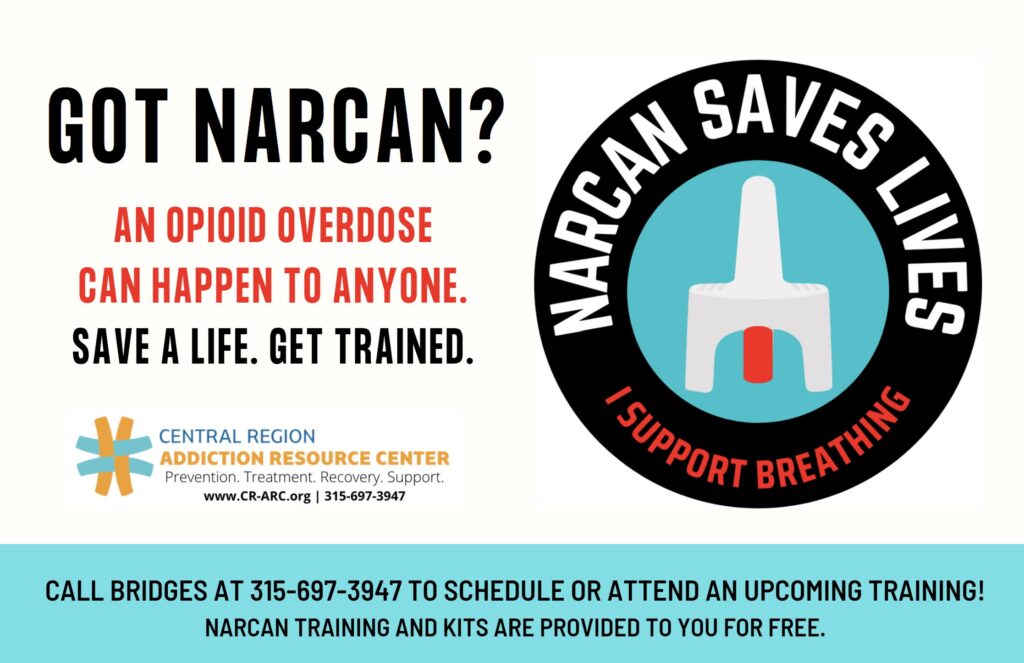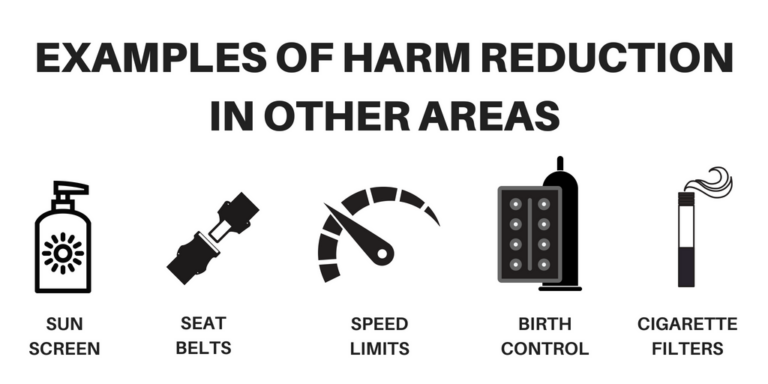Opioid overdoses occur when there is an overwhelming amount of opioids in the body resulting in shallow or no breathing. When Narcan is administered it supports breathing until EMS arrives for further medical intervention. Narcan and Narcan training is provided to you free of charge by the Central Region Addiction Resource Center. Anyone who use opioids can experience an overdose at any time. When a person survives an opioid overdose, it’s because someone knew what was happening and how to take action.
Narcan saves lives. Let’s get this into yours. Get trained today!

Recently released data by the Center for Disease Control, shows that drug overdose deaths reached a record high of 93,331 in 2020. While these estimates are not final, this is more than 20,000 deaths above the previous high in 2019 and the largest single-year percentage increase on record since 1999. NYS overdose deaths increased over 30% in 2020 alone. The rapid increase was driven by the presence of fentanyl as well as pandemic-related barriers including access to adequate care. Officials said the increase was driven by the lethal prevalence of fentanyl as well as pandemic-related stressors and problems in accessing care.
To find an Opioid Overdose Prevention Program near you please click on the County below.
Farnham Family Services
283 West 2nd Street, Suite 200
Oswego, NY 13126
315-342-4489
Oswego County Health Department
70 Bunner Street
Oswego, NY 13126
315-349-3555
Oswego City Police Department
169 West 2nd Street
Oswego, NY 13126
315-343-1212
Beacon Center
20 Crawford Street
Cortland, NY 13045
716-831-1937 ext. 103
Cortland Area Communities That Care
45 Crandal Street
Cortland, NY 13045
607-218-5488
Family Counseling Services of Cortland County, Inc.
165 Main Street, Suite A
Cortland, NY 13045
607-756-3787
Guthrie Cortland Medical Center
134 Homer Ave., Attn: Pharmacy Dept.
Cortland, NY 13045
607-756-3787
Healing Cayuga
146 North Street
Auburn, NY 13021
315-253-1522
Farnham Family Services
13 Chapel Street
Auburn, NY 13021
315-702-8460
BRiDGES / Madison County Council on Alcoholism & Substance Abuse, Inc.
1507 Upper Lenox Ave.
Oneida, NY 13421
315-697-3947
Family & Children’s Counseling Services
201 Cedar Street
Oneida, NY 13421
315-280-0400
Oneida Healthcare
321 Genesee Street
Oneida, NY 13421
315-361-2080
Morrisville State College, Mathis Student Health Center
80 Eaton Street
Morrisville, NY 13408
315-684-6239
ACR Health
637 West Genesee Street
Syracuse, NY 13204
315-898-2497
Barnes Center at The Arch Health Promotion
150 Sims Drive, Suite 104
Syracuse, NY 13244
315-443-8000
Center for Justice Innovation-Westside Community First
120 East Washington Street, Suite 731
Syracuse, NY 13202
315-278-2740
Dr. Ted J. Triana
2700 Court Street, 2nd Floor
Syracuse, NY 13208
315-480-3040
Conifer Park Liverpool
526 Old Liverpool Road, Suite 4
Liverpool, NY 13088
315-453-3911
Crouse Health Addiction Treatment Services
2775 Erie Blvd E.
Syracuse, NY 13224
315-470-8340
Crouse Health Commonwealth Place
6010 East Molloy Road
Syracuse, NY 13211
315-434-2470
Crouse Health Health Department
736 Irving Avenue
Syracuse, NY 13210
315-470-1016
Helio Health Administration Office
518 James Street
Syracuse, NY 13202
315-474-5506
Helio Health Chemical Dependency Outpatient Program
329 North Salina Street
Syracuse, NY 13203
315-474-5506 ext. 237
Prevention Network CNY
906 Spencer Street
Syracuse, NY 13204
315-471-1359
Onondaga County Health Department
421 Montgomery Street, 9th Floor
Syracuse, NY 13202
315-435-3664
SUNY Upstate University Hospital Medical Toxicology Service
750 East Adams Street, Inpatient Pharmacy
Syracuse, NY 13202
716-863-9574
Syracuse University
150 Sims Drive, Suite 104
Oswego, NY 13244
315-443-8000
University Police Department State University of New York Upstate Medical University
750 East Adams Street
Syracuse, NY 13210
315-464-4156
An opioid overdose happens when a person takes too much of an opioid, or combination of opioids and other drugs, at a level that is toxic to the body. Sometimes it can be hard to tell if a person who is using opioids is just very high, or actually experiencing a life-threatening overdose. If you are unsure, it is best to assume there is an overdose — you could save a life. Signs of an overdose include:
BRiDES/MCCASA is certified as an Opioid Overdose Prevention Program that is recognized by the Office of Addiction Services and Support Services (OASAS). The certification allows for BRiDGES/MCCASA (and the Central Region Addiction Resource Center) to provide training to the community on how to recognize respond appropriately to an overdose. The appropriate response to an opioid overdose includes calling 911 and administering naloxone (Narcan), an opioid antagonist that reverses an overdose’s potentially life-threatening consequences.
BRiDES is certified as an Opioid Overdose Prevention Program that is recognized by the Office of Addiction Services and Support Services (OASAS). The certification allows for BRiDGES (and the Central Region Addiction Resource Center) to “provide training to individuals in the community on how to recognize an overdose and how to respond to it appropriately. The appropriate responses to an opioid overdose include calling 911 and administering naloxone (Narcan), an opioid antagonist which reverses the potentially life-threatening consequences of an overdose.”
Additionally, the Central Region Addiction Resource Center offers education, resources, and supplies as a part of the Opioid Overdose Prevention Program.
Harm reduction is a set of practical strategies and ideas aimed at reducing negative consequences associated with drug use. Harm Reduction is also a movement for social justice built on a belief in, and respect for, the rights of people who use drugs.
Harm reduction incorporates a spectrum of strategies that includes safer use, managed use, abstinence, meeting people who use drugs “where they’re at,” and addressing conditions of use along with the use itself. Because harm reduction demands that interventions and policies designed to serve people who use drugs reflect specific individual and community needs, there is no universal definition of or formula for implementing harm reduction.
We utilize harm reduction strategies everyday without even realizing it!

Opioids are a class of drugs that include the illegal drug heroin, synthetic opioids such as fentanyl, and pain relievers available legally by prescription, such as oxycodone (OxyContin®), hydrocodone (Vicodin®), codeine, morphine, and many others.
For more information, visit our resources page.
What is an overdose?
According to the CDDC, nearly 841,000 people have died since 1999 from a drug overdose. Over 70% of drug overdose deaths in 2019 involved an opioid. Opioids are substances that work in the nervous system of the body or in specific receptors in the brain to reduce the intensity of pain.
Overdose deaths involving opioids, including prescription opioids, heroin, and synthetic opioids (like fentanyl), have increased over six times since 1999.1 Overdoses involving opioids killed nearly 50,000 people in 2019, and nearly 73% of those deaths involved synthetic opioids.2
An opioid overdose happens when a toxic amount of a drug, or combination of drugs overwhelms the body.
When an overdose occurs due to an Opioid, Opioids fit into specific receptors in the brain that relax breathing. During an overdose, breathing can be dangerously slowed or stopped, causing brain damage or death. It’s important to recognize the signs and act fast.
Non-Fatal Overdose VS. Fatal Overdose Statistics
According to the CDC, for every drug overdose that results in death, there are many more nonfatal overdoses, each one with its own emotional and economic toll. This fast-moving epidemic does not distinguish among age, sex, or state or county lines.
Deterra is on a mission to prevent drug abuse and protect our environment through safe, permanent disposal of unused prescription and over-the-counter medications. The Deterra Drug Deactivation and Disposal System is the only product that is independently tested and scientifically proven to destroy drugs for good. Our patented, easy-to-use drug disposal system can be used at home or in a clinical setting to safely destroy unused or expired medications, making them unavailable for misuse and safe for disposal in the normal trash.
An opioid overdose happens when a toxic amount of a drug,
or combination of drugs overwhelms the body.
When an overdose occurs, Opioids fit into specific receptors in the brain that relax breathing. During an overdose, breathing can be dangerously slowed or stopped, causing brain damage or death. It’s important to recognize the signs and act fast.
NARCAN (Naloxone HCI) is a nasal spray that reverses opioid overdoses. It’s easy to use, and it can save someone’s life.
Please remember: before you administer NARCAN, you need to call 911. Sometimes it takes more than one dose to reverse an overdose, and medics need to provide additional aid.Naloxone, also known by the brand name Narcan®, is a drug created to reverse opioid overdose. It can quickly restore normal breathing and save the life of a person who is overdosing on opioids, like heroin or prescription pain medicines.
The Central Region Addiction Resource Center provides Narcan trainings, FREE OF CHARGE.

Signup for our newsletter and stay up to date with
events, news, education, and advocacy!
BRiDGES/MCCASA, CRARC
P.O. Box 389
1507 Upper Lenox Ave.
Oneida, NY, 13421
Email us | (315) 697-3947
© Central Region Addiction Resource Center. All Rights Reserved. | Website Design and Development by Flourish Design Studio, Ithaca New York